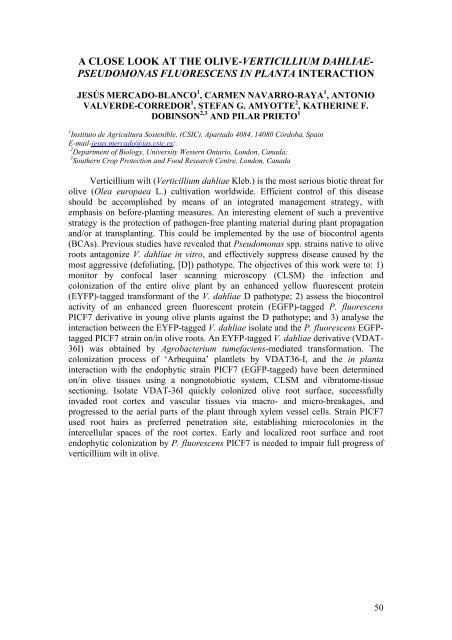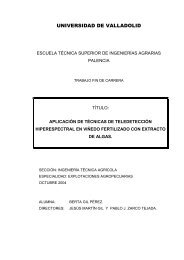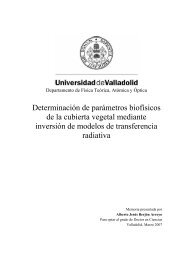10th INTERNATIONAL VERTICILLIUM SYMPOSIUM 16-20 ...
10th INTERNATIONAL VERTICILLIUM SYMPOSIUM 16-20 ...
10th INTERNATIONAL VERTICILLIUM SYMPOSIUM 16-20 ...
You also want an ePaper? Increase the reach of your titles
YUMPU automatically turns print PDFs into web optimized ePapers that Google loves.
A CLOSE LOOK AT THE OLIVE-<strong>VERTICILLIUM</strong> DAHLIAE-PSEUDOMONAS FLUORESCENS IN PLANTA INTERACTIONJESÚS MERCADO-BLANCO 1 , CARMEN NAVARRO-RAYA 1 , ANTONIOVALVERDE-CORREDOR 1 , STEFAN G. AMYOTTE 2 , KATHERINE F.DOBINSON 2,3 AND PILAR PRIETO 11 Instituto de Agricultura Sostenible, (CSIC), Apartado 4084, 14080 Córdoba, SpainE-mail-jesus.mercado@ias.csic.es;.2 Department of Biology, University Western Ontario, London, Canada;3 Southern Crop Protection and Food Research Centre, London, CanadaVerticillium wilt (Verticillium dahliae Kleb.) is the most serious biotic threat forolive (Olea europaea L.) cultivation worldwide. Efficient control of this diseaseshould be accomplished by means of an integrated management strategy, withemphasis on before-planting measures. An interesting element of such a preventivestrategy is the protection of pathogen-free planting material during plant propagationand/or at transplanting. This could be implemented by the use of biocontrol agents(BCAs). Previous studies have revealed that Pseudomonas spp. strains native to oliveroots antagonize V. dahliae in vitro, and effectively suppress disease caused by themost aggressive (defoliating, [D]) pathotype. The objectives of this work were to: 1)monitor by confocal laser scanning microscopy (CLSM) the infection andcolonization of the entire olive plant by an enhanced yellow fluorescent protein(EYFP)-tagged transformant of the V. dahliae D pathotype; 2) assess the biocontrolactivity of an enhanced green fluorescent protein (EGFP)-tagged P. fluorescensPICF7 derivative in young olive plants against the D pathotype; and 3) analyse theinteraction between the EYFP-tagged V. dahliae isolate and the P. fluorescens EGFPtaggedPICF7 strain on/in olive roots. An EYFP-tagged V. dahliae derivative (VDAT-36I) was obtained by Agrobacterium tumefaciens-mediated transformation. Thecolonization process of ‘Arbequina’ plantlets by VDAT36-I, and the in plantainteraction with the endophytic strain PICF7 (EGFP-tagged) have been determinedon/in olive tissues using a nongnotobiotic system, CLSM and vibratome-tissuesectioning. Isolate VDAT-36I quickly colonized olive root surface, successfullyinvaded root cortex and vascular tissues via macro- and micro-breakages, andprogressed to the aerial parts of the plant through xylem vessel cells. Strain PICF7used root hairs as preferred penetration site, establishing microcolonies in theintercellular spaces of the root cortex. Early and localized root surface and rootendophytic colonization by P. fluorescens PICF7 is needed to impair full progress ofverticillium wilt in olive.50




